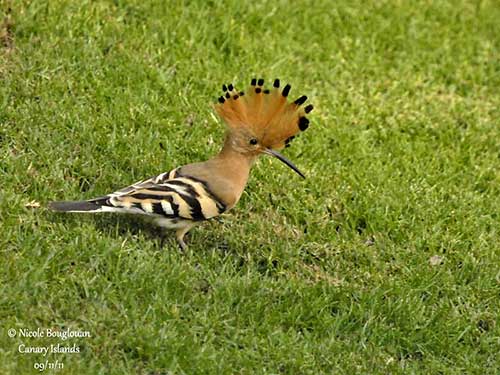
Page under
copyright !
TO BE CONTINUED... Page 16 (First part)
Text by Nicole Bouglouan
Photographers:
Didier Buysse
Vision d’Oiseaux
Jean Michel Fenerole
Photos d’Oiseaux du monde
Steve Garvie
RAINBIRDER Photo galleries & Flickr Rainbirder
Ken Havard
My Bird Gallery & Flickr gallery 1 & Flickr gallery 2
Jean-Claude Jamoulle
A la rencontre des Oiseaux
Otto Plantema
Trips around the world
Dubi Shapiro
Dubi Shapiro Photo Galleries
Françoise Vareille (Reproduction of the Eurasian Hoopoe 2017)
Ingo Waschkies
My bird pictures on Pbase
Callie de Wet
GALLERY
Nicole Bouglouan
Photographic ramble
These images and the text are subject to copyright and cannot be used without express authorization from the owners. Legal issues
Sources :
HANDBOOK OF THE BIRDS OF THE WORLD Vol 6 by Josep del Hoyo-Andrew Elliott-Jordi Sargatal - Lynx Edicions, 2001 - ISBN: 848733430X
L’ENCYCLOPEDIE MONDIALE DES OISEAUX - Dr Christopher M. Perrins - BORDAS - ISBN: 2040185607
BIRDS OF AFRICA SOUTH OF THE SAHARA by Ian Sinclair and Peter Ryan - Princeton University Press Princeton and Oxford - ISBN: 0691118159
Bird nests: Variety is Key for the world’s avian Architects
Be on the lookout for bird nests
The design and function of birds' nests
Wikipedia, the free encyclopaedia
ScienceBlogs - Hoopoes and woodhoopoes
The bird and its nest, where everything starts…
Page 15: Upupidae, Phoeniculidae, Bucerotidae and Bucorvidae
At the beginning of the breeding season and following several courtship displays, the nest-site is selected by the pair, or one of the members of the pair, and the nest is built within this area. For numerous species, the nest is the place where displays and copulation occur. It plays a very important role during the nesting period. It is the cradle of the chicks, the place where the adults feed them prior to their first flight towards independence.
The family Upupidae gathers four species of the genus Upupa, including one extinct species, the Saint Helena hoopoe (Upupa antaios). This species was endemic to Saint Helena Island in the South Atlantic Ocean. It was probably flightless, following the discovering of a left humerus, significantly different from that of other Upupidae species.
The three other species are found in the Old World and are widespread in Europe, Asia, and North Africa, Sub-Saharan Africa and Madagascar.

Hoopoes are medium-sized birds and the most distinctive morphological feature is the conspicuous fan-like erectile crest with broad black tips. The bill is long and slightly decurved. The broad, rounded wings and the square-ended tail are black and white.
The plumage of the Eurasian Hoopoe is pinkish to sandy-buff on head, neck and mantle, and more pinkish on the underparts. Rump and belly are white. The African Hoopoe is darker and more chestnut, whereas the Madagascan Hoopoe has dull grey mantle and is larger. Formerly, only one species, Upupa epops was in this genus, with several subspecies.
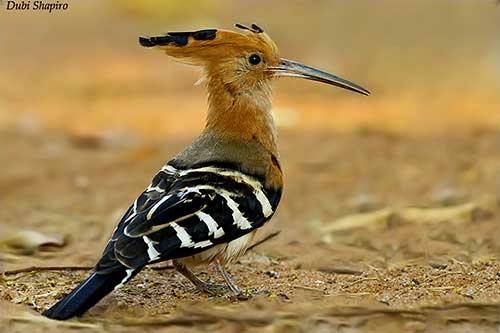
Hoopoes have an erratic, butterfly-like flight involving strongly undulating pattern. They live in farmland with old buildings and walls providing nesting cavities to these birds, in pastures bordered with trees, wooded steppes, savannas, plantations, but the African Hoopoe also frequents open and brushy areas. The densities are usually higher near villages and habitations providing more nesting sites.
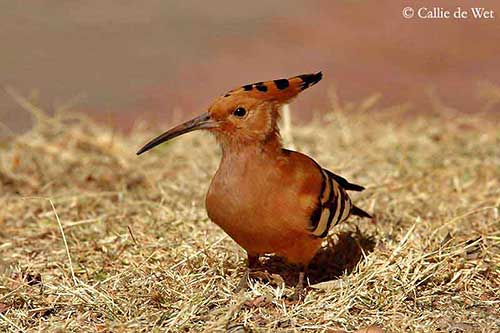
Hoopoes are not very gregarious. They feed singly or in pairs and are diurnal. At dusk, they roost mainly in trees, in pairs or solitary. Upupidae feed almost entirely on animal food, occasionally supplemented by seeds, berries, leaves, stems and rhizomes. They are mainly insect-eaters and use their long, decurved bill to extract ground-living prey, larvae and pupae of insects. The diet consists of beetles and their larvae, caterpillars, pupae of moths, locusts, grasshoppers, bugs, cicadas and others, including ants. Lizards are also taken, and the largest prey are beaten on the ground before to be eaten.
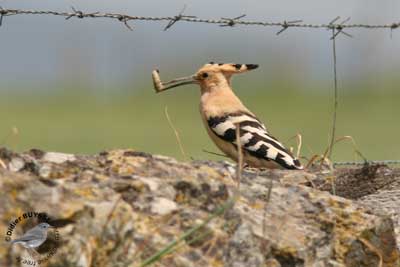
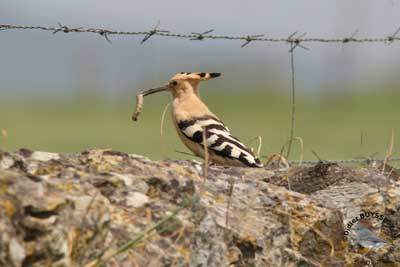
They breed solitary and the pairs are territorial. The male gives a typical advertising song, a resonant, hooting phrase “hoop-hoop-hoop” uttered from a perch high in tree or from a rooftop.
The male’s song of the Madagascan Hoopoe is mostly a soft, resonant, rolling purr “rrrrààààooooo” regularly repeated.
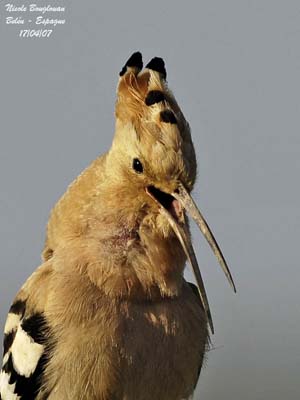
Singing
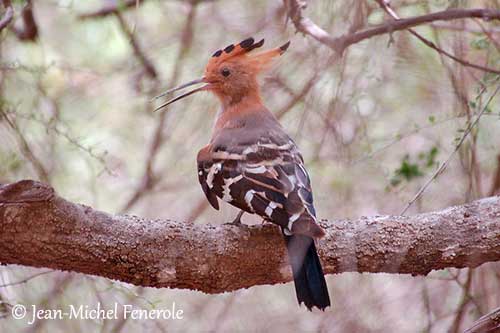
Singing
They are monogamous although the bond may last only one season among resident populations. The nest-site is often used from year to year. The male establishes the territory by singing, and fighting may sometimes occur. Aerial and terrestrial chasings between males, but also between females have been recorded. Fighting between two males is common but may become severe while the opponents leap and flutter in the air.
During the pre-breeding period, courtship feeding begins. Then, the male starts to search for nest-sites and establishes the territory.
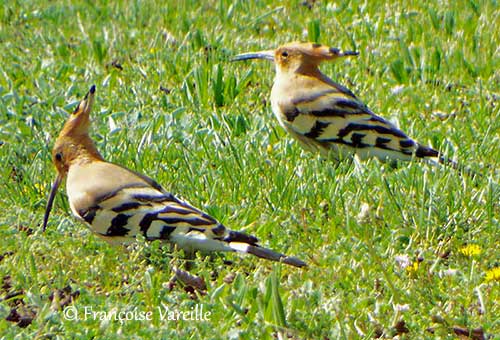
Pair
The nest is in a hole in tree or wall, rocky crevice or in old building, and even in termite mound. Nest-boxes and other artificial structures can be regularly occupied. The nest can be placed from 2 to 12 metres above the ground. The male, sometimes with the female, clears the cavity but they do not excavate. There is little or no nest material added in the cavity, but in some cases, grass, leaves, wool and feathers can be used as lining.
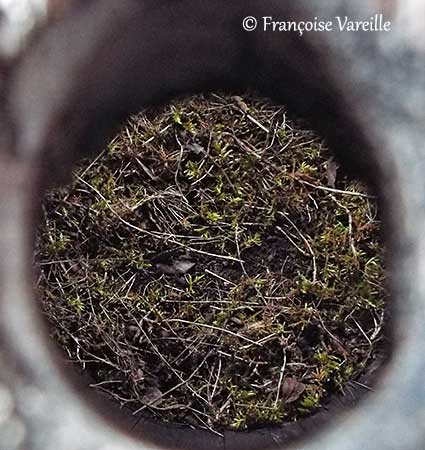
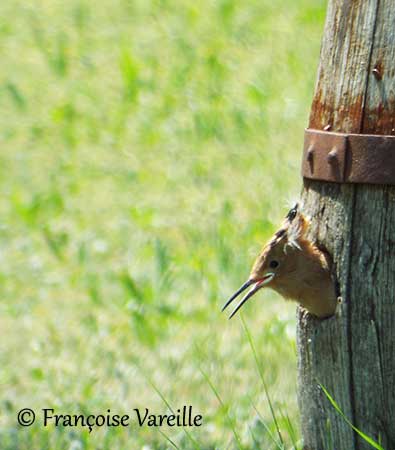
Chick at the entrance
The clutch size varies depending on the range. The hoopoes usually lays between five and twelve eggs, usually mostly six to nine creamy-white eggs becoming progressively pale dirty grey. They are laid at daily intervals.
The female incubates alone but she is often fed by the male. The hatching occurs after 15-18 days of incubation. The downy chicks are white first, but they are quickly covered in long spiny quills prior to feather’s appearance. The nestling period lasts about 25-30 days.
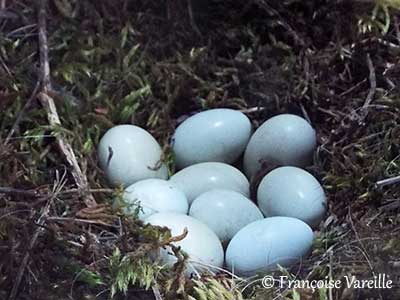
Nest with nine eggs
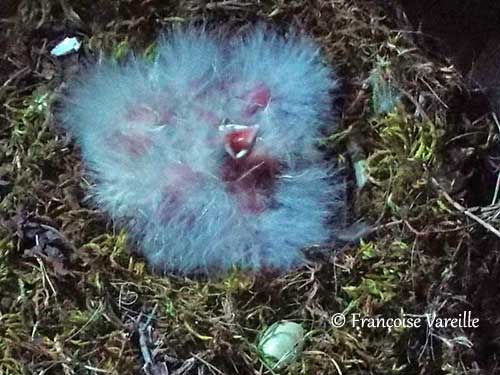
Five white downy chicks
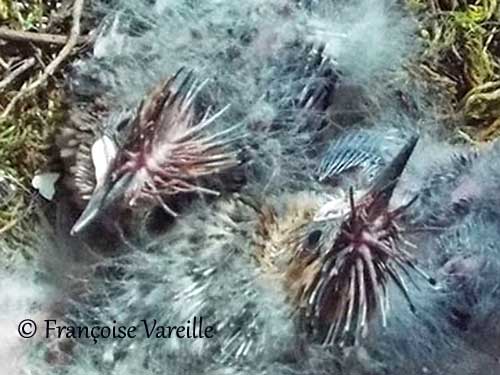
Chicks covered in long spiny quills
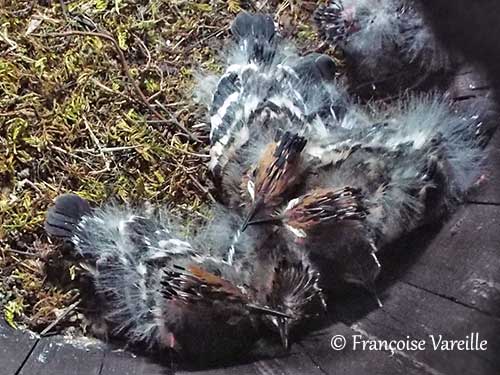
The feathers are growing
In response to predators, both female and young produce an evil-smelling fluid resembling to rotting meal. In addition, six days old nestlings are able to squirting liquid faeces and cloacal contents at intruder in the nest. However, the chicks usually defecate along the rear wall of the cavity and the nest-hole becomes rapidly foul-smelling.
Hoopoes usually produce one brood per season, but several pairs may have two broods and the breeding success seems to be relatively high.
The family Phoeniculidae gathers medium-sized, arboreal birds with generally black, iridescent plumage. This family contains two genera, Phoeniculus with the typical woodhoopoes, and Rhinopomastus with the scimitarbills.
All species occur in Sub-Saharan Africa where they frequent wooded habitats from lowland rainforest to arid bush country. They are cavity-nesters and require large trees for nesting, roosting and feeding.
Both woodhoopoes and scimitarbills have long, slender body, long tail and long, decurved bill. The large wings often involve floppy or jerky flight from tree to tree, but the movement is usually powerful, and these birds can fly strongly and swiftly and are able to sustain the effort over extended periods of time.
The bill may vary according to the species. It can be red or black, and the colour may be related to the age of the bird. It is long and decurved, well-adapted to the foraging behaviour of these birds.
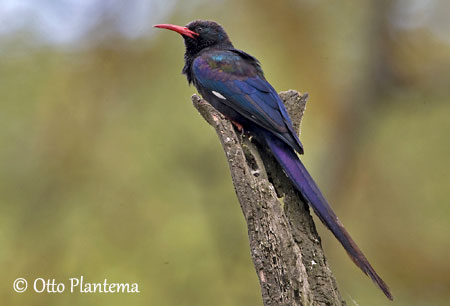
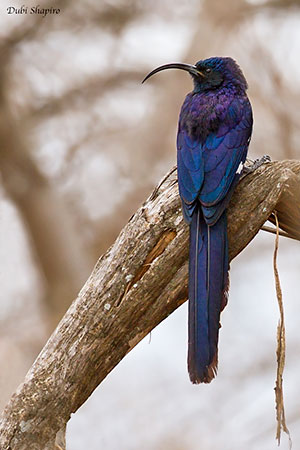
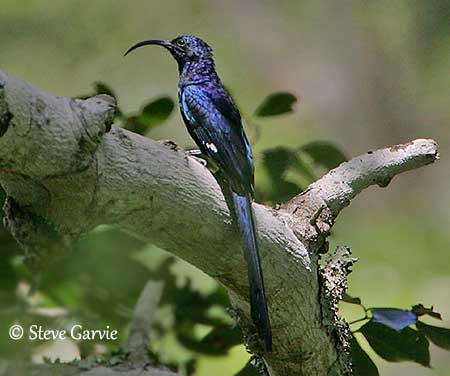
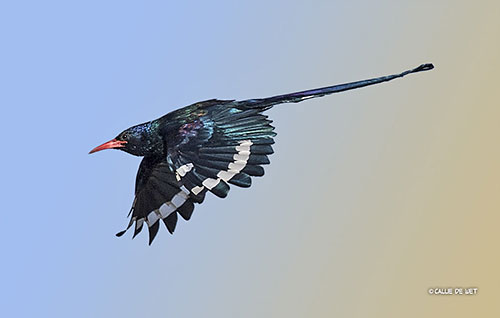
They are mainly arboreal and forage quietly in trees, although they may occasionally descend to the ground for foraging while moving by hopping. When feeding in trees, they move up trunks, limbs and branches of trees with agility.
All species use the specialized bill to probe into bark crevices or to glean insects from small twigs. The short, thick legs and the very strong feet with sharply curved claws, allow the birds to hold itself in place while foraging perpendicular to trunk or branch, or to hang on the underside of horizontal branch or even to hang upside-down. The long tail is used as a support, and the birds often show worn tail feathers. The Common Scimitarbill is able to move down the trunk with head pointed downwards.
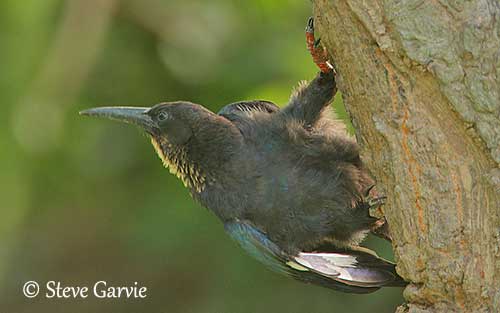
Immature
They feed primarily on arthropods including larval and adult insects of various species, spiders, millipedes and centipedes, but also eggs of both spiders and insects. Small lizards and eggs of small bird species are taken by the Green Wood Hoopoe in West Africa. Some species also consume berries and seeds as supplement to animal prey.
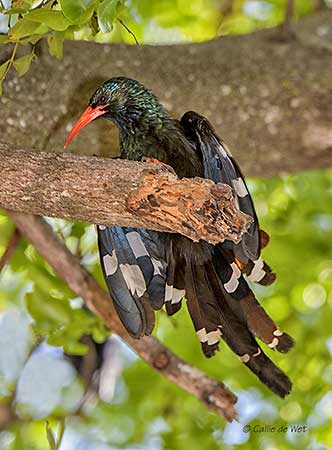
Woodhoopoes are noisy birds and their vocalizations play an important role in the social life. In contrast, the Forest Woodhoopoe and the three scimitarbills are not highly social and they have softer, less noisy calls.
Several displays accompanied by calls are reported at territory boundaries. The birds give prolonged chuckling or cackling sounds “kak-kak-kkkkk” similar to the hysterical laughter of humans.
The Phoeniculidae are cavity-nesters and usually nest in tree cavities, both natural hollows and holes excavated by woodpeckers.
The three scimitarbills of genus Rhinopomastus have typical avian pattern, with a single male and a single female sharing the nesting duties. In contrast, several species of genus Phoeniculus engage in co-operative breeding characterized by the presence of mature non-breeding birds in addition to the pair.
All Phoeniculidae are monogamous, including the co-operative breeding birds. Both mates spend much time together, engaged in mutual grooming and periodic copulation. The male often feeds the female prior to the egg-laying.
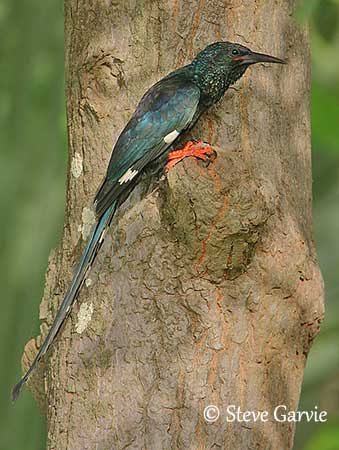
They do not perform any nest construction. The location of the nest-sites may vary, depending on site availabilities.
They may sometimes remove the materials placed in the hole by other species, although the Common Scimitarbill brings some materials such as lichens or dead leaves to the cavity.
The clutch size ranges from 2 to 5 blue, grey or olive, unmarked eggs, usually 3-4, and the Phoeniculidae usually produce slightly larger clutches than the Rhinopomastus, but more study is required.
The incubation lasts about 17-18 days, and is mainly conducted by the breeding female alone. She is fed by her mate and helpers. The downy chicks are fed by both male and helpers with small food items.
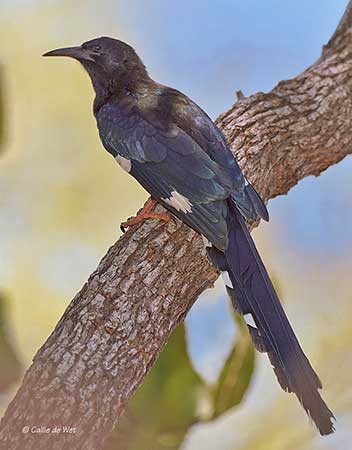
Immature with black bill
Like in Upupidae, the nest becomes foul-smelling because the dejections of the young are not removed. However, the young birds use only one spot to defecate in the nest. When fledged, the juveniles are fed and protected by the flock for several weeks.
The family Bucerotidae gathers the typical hornbills. They are easily recognizable by their long, decurved bill, surmounted by a casque in several species. They occur across Sub-Saharan Africa and South-East Asia. They are mostly birds of forest and are usually sedentary or perform only some short-distance movements in search of food. They are omnivorous, eating both small animal prey and vegetable food items, mainly fruits. They breed in natural cavities, and their breeding behaviour has long attracted attention.
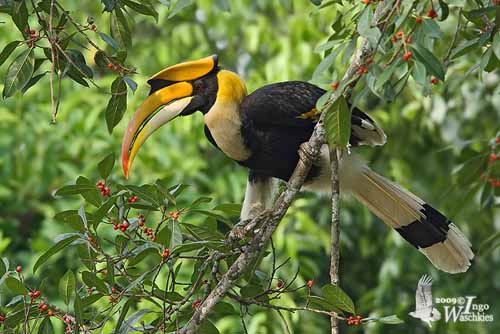
This family includes numerous genera, but they have several common features and behaviours. The main common feature is the bill. It is always large, more or less long or thick, but strong, with casque or not. The male is always larger than the female in size. Their plumage varies from black, white or grey to brown or cream. They show some distinctive patterns in flight. Usually, the bare parts are brightly coloured on face and throat.
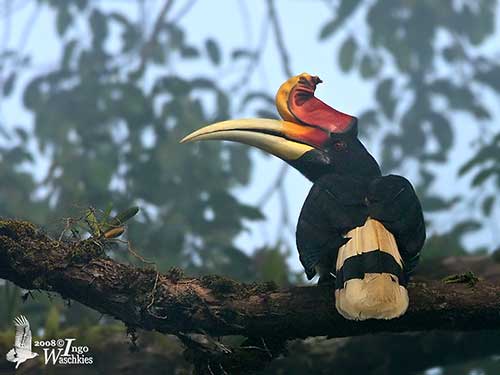
The casque is unique to the hornbills. It varies according to the species, showing a diversity of forms even among the members of the family. The development of this casque may last up to six years to be finished.
It is a hollow structure which functions as a resonating chamber, giving the loud nasal sounds uttered by large hornbill species. In the species with small casque, the throat inflates and plays a role in their calls.
Both bill and casque are used in aerial disputes between rival males. The bill is also used to chisel off bark. And the size of bill and casque may help to differentiate male and female.
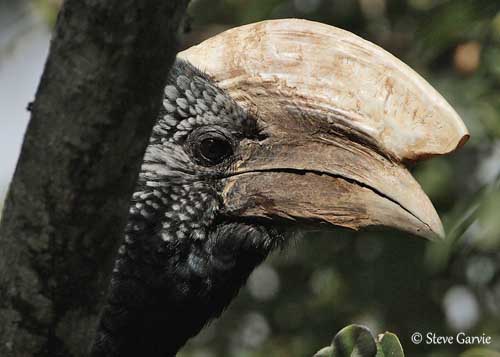
Most hornbills feed on animal and vegetal items, but they feed mainly on fruit and small animals, depending on food resources availability. They use the bill to take the food, picking up item where it is found or lifting leaves for hidden preys, or digging into the soil and under the bark. They snatch hanging fruit or insects from vegetation or ground while flying, and hawk aerial preys. They may swallow it whole but larger items are broken up.
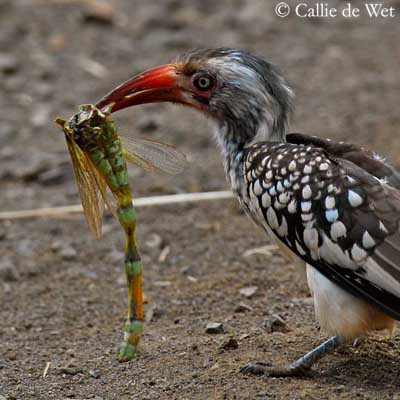
Hornbills nest in natural cavities, usually in trees but also in rock faces. The final selection is made by the female. The male often assists her, bringing food and nest materials.
The pair becomes territorial and defends the nest-site. The colours of the bare facial skin become brighter and are used in displays. The male frequently performs courtship-feeding.
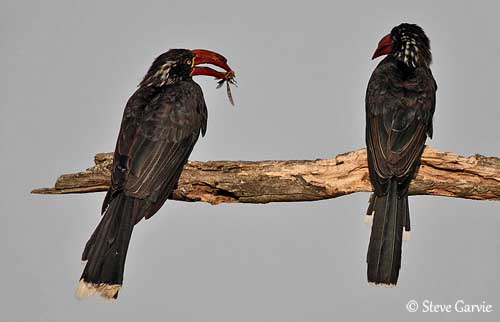
The female may spend long periods in the nest before to seal it, arranging the cavity. This behaviour may last several months until the breeding conditions become suitable.
At this moment, the female seals herself the nest, forming an elongated vertical slit. She sits in the nest and lays the eggs some days later. She lays one or two eggs in the large species, and up to eight for some small species. During the nesting period, the female moults. She is fed by the male.
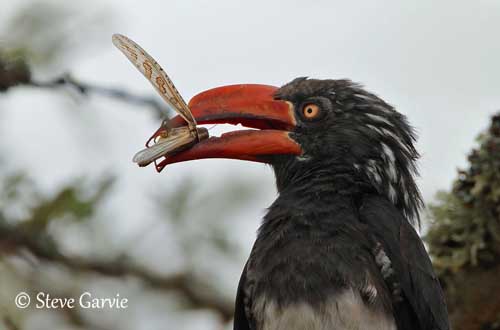
The incubation lasts from 23 to 42 days, according to the species. The smallest chicks often die by starvation.
The male brings food to the nest. In cooperative breeders, he has helpers.
The nestling period may last from 39-50 days for the smallest species, to 72-96 days in the largest ones.
The female emerges at the end of the nesting cycle. At this moment, she pecks away from within the hole with the bill and needs some hours to remove sufficient material.
Female and chicks fly immediately and do not return to the nest until the next season. The young remain around the nest for some days or weeks, and are fed by both parents. Then, they follow the adults for foraging.
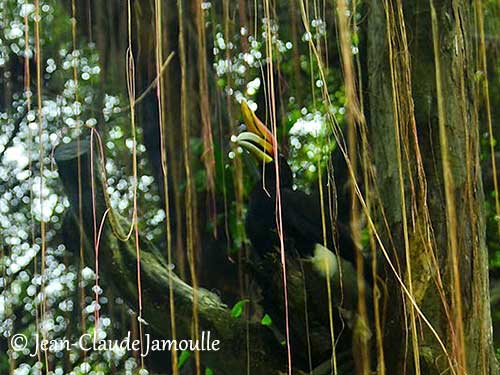
The family Bucorvidae is endemic to Sub-Saharan Africa and contains only two species with a single genus Bucorvus.
The Northern or Abyssinian Ground-hornbill and the Southern Ground-Hornbill are large birds of around a metre tall. Unlike the Bucerotidae, they are terrestrial and feed on the ground, but like other hornbills, they nest in natural cavities.
The Northern or Abyssinian Ground-hornbill has black plumage except the white primaries conspicuous in flight. The head shows red and blue skin patch around the eyes and the inflatable throat skin is blue and red. The high casque placed at the upper base of the bill is black too. We can see a ridge along each side, and an opening at the end of the casque.
The eyes are dark brown with long eyelashes that are modified feathers. Strong legs and feet are black.
The female only differs from the male by the colour of the throat skin which is entirely blue.
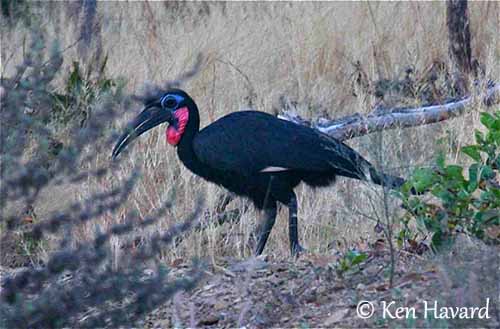
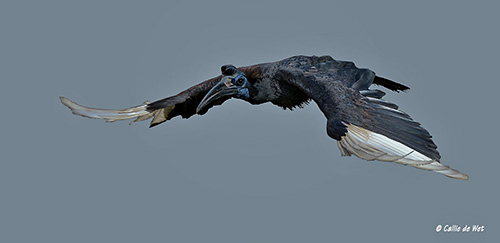
It is mainly carnivorous and feeds on reptiles, tortoises, lizards, but also mammals (hares) and mongooses. It also takes arthropods, various insects and spiders. Carrion is taken sometimes, but only to supplement live prey. It often follows groups of ungulates to take advantage of the disturbed preys, and it is also present at forest fires where it can catch fleeing animals.
The female lays 1-2 eggs and incubates during 37-41 days. The male feeds the female through the entrance, but the nest is not cleaned. The first-hatched chick grows rapidly, involving the death of the second chick by starvation.
The female leaves the nest after 21-33 days, and both parents feed the chick which fledges 80-90 days after hatching. It still depends on adults for food for several months.
The Southern Ground-Hornbill is slightly larger. It has black plumage and typical red-facial skin. It is a large black bird, with white flight feathers well visible in flight. It has bright red face and bare inflatable throat patches. The bill is powerful and black. It is well curved with a kind of hollow casque above.
The female is smaller. She has violet blue throat patches and less developed casque.
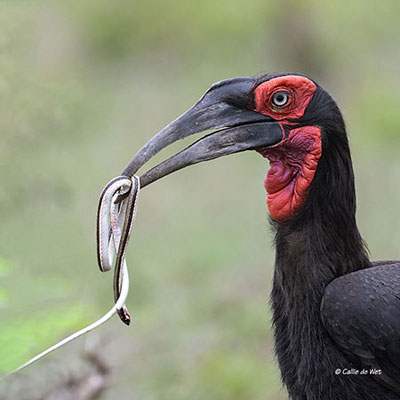

It is carnivorous too. It feeds on lizards, frogs, snails and insects (grasshoppers, beetles and termites), but also on small mammals, such as hares and squirrels, and also snakes. It may consume some vegetation (fruit and seeds) and sometimes scavenge.
It spends its time walking slowly along the ground, searching for food, mainly small animals and insects. It walks with stubby toes elevated, almost walking on tip-toe. It forages on the ground, digging with the bill for food. But to hunt some difficult prey such as snakes, they gather in groups. It uses its powerful bill to kill the prey. The larger prey are pursued and dismembered by several group members.
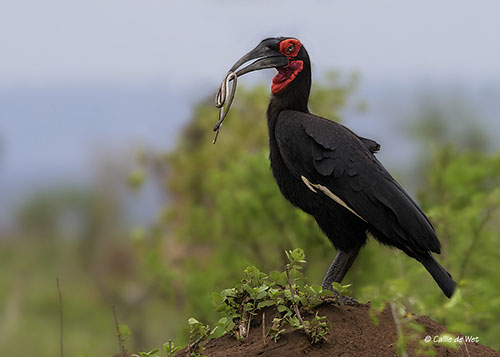
With prey
They live in groups of up to 12 birds. These groups include a single breeding pair or a dominant breeding pair with helpers of various ages, usually adult males and immatures of both sexes. They defend territories against other groups, chasing each other in aerial pursuits.
They nest in natural cavities and holes, in dead or live trees, or in cliffs. This species does not seal the nest entrance. The nest is built by breeding pair and helpers. It is lined with dry leaves and grasses.
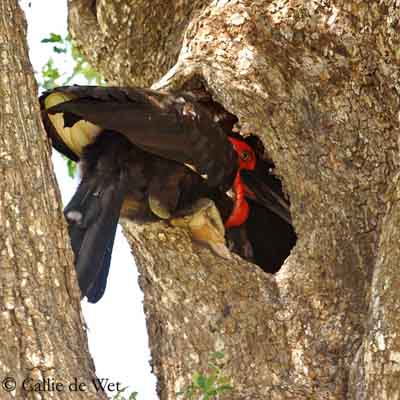
At nest entrance
The female usually lays two white eggs, but only one chick is raised. She incubates during about 40 days, during which she is fed by the members of the group. The oldest chick out-competes its younger sibling for food, and it dies within the first week. During the nestling period, the members of the group help the nesting pair to rear the young. It fledges about 86 days after hatching. It depends on adults for several months, sometimes one year.
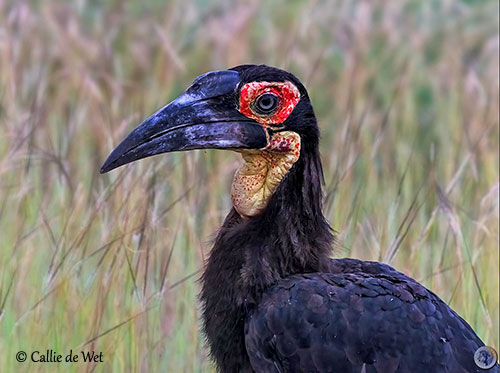
2d year

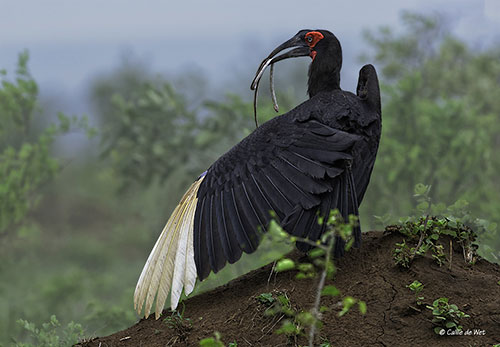
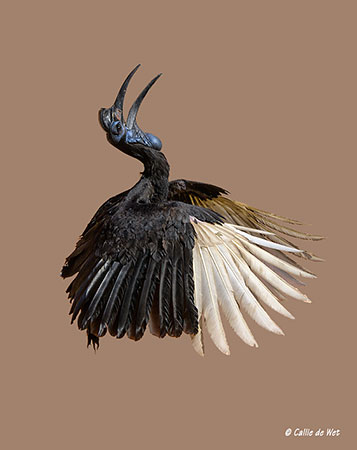
Northern or Abyssinian Ground-hornbill
Jumping to catch a prey